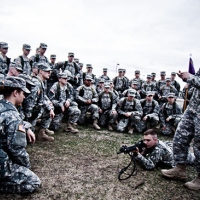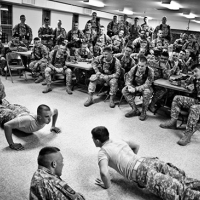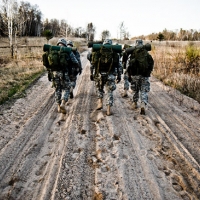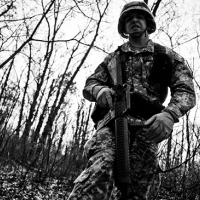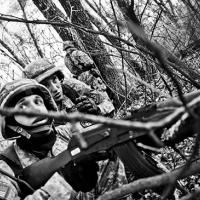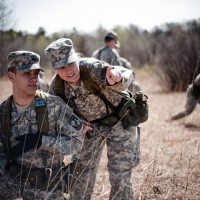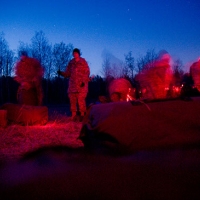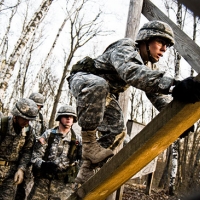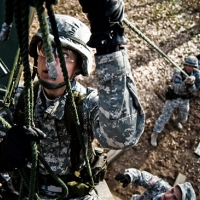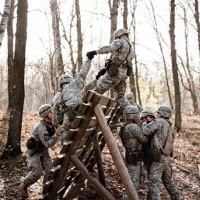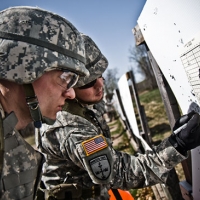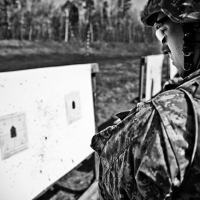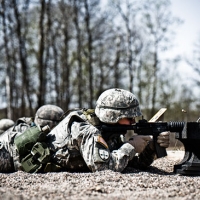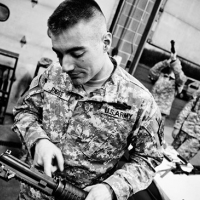Train as you fight: Embedded in the ROTC | The Gustavian Weekly.
Features article published April 30, 2010 by Alex Messenger Photography Editor
On April 17, I woke up at 5:00 a.m. under a still dark sky and scraped a thin film of ice off the inside of my sleeping bag. It had apparently gone below the projected 34 degrees we had prepared for. Over the course of the next half hour a platoon of camouflaged soldiers bathed in the red glow of their flashlights marched past as the sun rose and temperature steadily increased. The Army certainly starts the day early.
From April 15 to 18, I was embedded with the Army ROTC’s Maverick Battalion who were conducting their Joint Field Training Exercises (JFTX). The Maverick Battalion, composed of student cadets from Minnesota State University Mankato, Bethany Lutheran College and, of course, Gustavus, goes to Camp Ripley for field training exercises once in the fall and once in the spring. Within the battalion there are 13 Gustavus students.
At JFTX, Cadets hone myriad skills they have worked on and learned about in the classroom and in weekly labs, from land navigation and squad tactics to weapon maintenance and rifle marksmanship. “This exercise is introducing them to map reading and land navigation,” Senior Political Science Major and MS4 Jake Partridge said, who helped to run the land navigation training. “Tomorrow they’re going on an actual land nav course to find points. This is to ensure that they know how to find the points before they actually go out.”
While the Cadets searched their maps I spoke with Lieutenant Colonel Joel Stephenson, who is in charge of the Maverick Battalion. ROTC works very much like a college education. This is Stephenson’s first year with the battalion after almost two decades in the Army and two deployments to Iraq. His job is to “ensure that we’re guiding things correctly here and we’re teaching these Cadets what it’s like to be a leader in what is a very complex Army, or at least an Army that is in very complex environments right now.”
Marching around Camp Ripley, the first and second-year Cadets (Military Science, or MS1s and MS2s; seniors are MS4s) learned about weapon maintenance. In the dining hall of a barracks, Cadets worked with M4 assault rifles, learning the ins and outs of field stripping the weapon and getting it to fire if there is a malfunction on the range.
Cadets also got to practice firing the weapons before being on the live fire range. “There’s this system called the EST 2000,” which is a lot like duckhunt but with M16s and M4s, “and it’s like a virtual firing range where you get the chance to go through zeroing and qualifying virtually in order to get just another element of practice before you’re doing it for the real thing on the firing range,” Nick Bonestroo said, a senior accounting major and MS4. This additional layer of training and practice helps to ensure the cadets know what they’re doing and are conducting themselves safely once they are on the live fire range.
The next morning we headed out to do day land navigation. Cadets are given points which they plot on a map, and then they have to go find them, eight in total, of which they need five to pass. They have three hours to do it. I followed Sophomore Chemistry ACS Major Kevin Pelto as he navigated the course. Once we had the points plotted, we used landmarks such as roads, hills and woods combined with compass work to shoot azymiths, or headings, and then we walked into the woods following our invisible line until we found an orange and white cloth point marker amidst the old growth.
Cadets all have their own reasons for joining ROTC. “I am contracted. I contracted two [Thursdays] ago. The day before FTX,” Pelto said. He joined “partially because I’ve never done anything like ROTC before and [because] I would never have gone out in a big troupe to go camping or do squad tactics or go to a rifle range or anything like that on my own really … but ROTC also pays a hefty sum for my education … but now that I’m actually in the program, I actually like hanging out with a lot of these people.”
“Your first three years,” Bonestroo said, “you continually learn more and more about the training, and your [first] and sophomore year you’re kind of able to participate and everything, but you don’t really have a chance to earn a leadership role. Junior year you are routinely in leadership roles where you’ll be leading 9 to 12 people in various small training missions. Then senior year you kind of look back on all of those three years,” and help the younger Cadets learn and excel.
MS1s and MS2s also worked on the Field Leadership Reaction Course (FLRC) and small missions where they got a taste of how they’ll be tested between their junior and senior years at the Leadership Development Accession Course (LDAC). In these exercises, Cadets lead squads to complete missions on obstacle courses and over terrain. They are essentially problem solving and leadership tests, and the cadets are evaluated and given feedback on how to improve their performance. These types of exercises and the scores they receive from them at LDAC, along with grades, physical fitness test results and extracurricular involvement determine each Cadet’s national rank and their priority for getting the job within the Army that they want following their graduation and commissioning as an officer.
After brushing the ice off my sleeping and camera bags, we stood at attention in frigid formation as we were briefed about the day. The MS4 cadet addressing the MS1 and MS2 platoons stressed the importance of safety on the range: “Today you will be qualifying on the live fire range. You will be firing live rounds. This is very dangerous; people could literally die.” He stressed the importance of following instructions to the letter and everyone being their own and everyone else’s safety. To be in the Army seems like a dangerous endeavor, but one of their main foci is to protect Cadets and soldiers in the training process so they can fulfill their mission and duty once in their combative or supporting roles.
At the live fire range we were issued M4s and body armor. “You see, one of our training principles would be ‘you train as you fight,’” Stephenson said. “So walking around the streets of Afghanistan or Iraq, you’re going to be wearing 40 or 50 pounds-worth of gear that would include your IBA, or your individual body armor, helmet, weapon and some sort of load bearing equipment. Part of it is you want [the Cadets] to get accustomed to shooting in that and then part of it is safety.”
After going through various safety checks and putting on ear protection, eye protection, a helmet and the body armor we zeroed our rifles. “We did rifle zeroing where we just repeat shooting a paper target and then adjust our sights so that we get a better picture for our shot to hit the center of the target,” Pelto said. The target, 25 meters away, had a tiny silhouette a little over one-and-a-half inches wide and about three inches tall nervously waiting to be hit as we looked down the iron sights of the rifle.
“At spring FTX we did range qualification which is where they have pop-up targets that you shoot after you zero. There’s one round of 20 targets and two rounds of ten [where] you have to be in different positions for shooting,” Pelto said. Green, torso-sized models would pop up from anywhere between four and ten seconds and anywhere from 25 meters to 300 meters away. “I had no idea the targets popped up or that they fell down right when you hit them or anything like that, but once that was all explained to me it went pretty smoothly,” Pelto said.
You’d sit there waiting for the target and once that 300 meter target which you can hardly see does pop up, you line up your sights, steady your crouching body and exhale slowly before squeezing the trigger. I more felt than heard the ear-plug-muffled bang and pop of the M4 as my body rocked back with the recoil and the smell of gunpowder filled the air. The green silhouette went down, confirming the hit. It’s truly amazing to think that without any assistance from optics, I’d sent a tiny projectile 300 meters down-range and hit the target.
After baking in the sun at the range, Cadets had a brief introduction to detecting IEDs before heading back to the barracks for dinner and rifle cleaning and a late night ride back to St. Peter.
“[FTX is] kind of like passing the final exam of the year,” Master Sergeant Friend, one of the officers from MSU said.
“I mean these kids within a year, 15 or 16 of them that graduate here next month are going to be sitting on the streets of Afghanistan or Iraq, and… they’re trained more lethally, more kinetically. We’re all kind of roughly familiar with that aspect of the Army, but some of the things that the Army is doing over there, or 22, 23-year-old leaders are doing, you and I … wouldn’t think the Army’s doing those things. It’s working with local tribal leaders to form some semblance of local government or working with some local business leaders to maybe provide some stimulus to their local economy or provide some goods and services,” Stephenson said.
“What we’re teaching them here is the bare, basic minimum. When you’re talking deployments and a lot of things like that, after these cadets get through here they’re going to be going to other schools that are more advanced levels to get into their job specialties,” Friend said.
Not unlike a traditional career path, Cadets have some say in choosing their branch within the army. “Really, I wanted to be in combat,” Senior Geography Major and MS4 Troy French said. “I wanted to feel what the American military man feels with being in the military—death is only centimeters away and I wanted to feel what that felt like. Yet again I wanted to help the nation that we’re helping. I want to help our nation to be better and I can’t wait until I’m helping another nation rebuild itself … To know that I did something and helped someone else.” French will be an infantryman, stationed in Germany after further training.
Jake Partridge will be branching Military Intelligence. “That was my first choice branch. I ended up getting it,” he said.
Senior Geography Major and MS4 Ben Baucknecht “is also going to be an infantryman,” Stephenson said. All of the graduating cadets will be attending basic officer leadership courses in their respective specialties.
“I’m going into the signal corps, which is the Army’s communications branch,” Bonestroo said. “I’ll be in charge of a group of probably 20 or 30 guys, and it’ll be our mission to help the first cavalry division with sending out, maintaining, establishing and securing command and control networks both locally and, more importantly, when they’re deployed overseas so that when they communicate with whoever they’re in touch with, they can always count on it being there and not have the enemy listen in to what they’re saying.”
We are all feeling the approaching end of the school year, especially graduating seniors—and the Cadets are no different. “It’s come way too fast, way too fast … but I think that I’m ready to go on with the next part of life and move on to the real thing pretty soon,” Bonestroo said.

